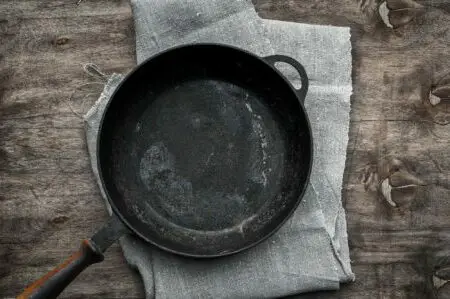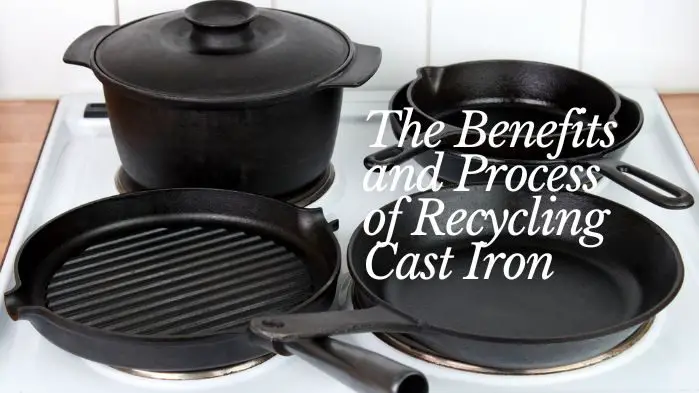Cast iron can be recycled. It is often recycled because it is a valuable material that can be used in many applications.
Cast iron can be melted down and used to create new cast iron products or processed and used as a feedstock for steel production. If you want to recycle cast iron, you can usually take it to a scrap metal yard or recycling center that accepts ferrous metals. They will be able to recycle it for you.
How to Recycle Cast Iron
Here are some steps you can follow to recycle cast iron:
- Find a recycling center that accepts ferrous metals. These are typically easy to locate as they often have large signs that say “Scrap Metal” or “Ferrous Metal Recycling.”
- Separate cast iron from other materials. Cast iron should be kept separate from different types of metal, as it has a higher value and is typically processed differently.
- Remove any non-metal attachments or contaminants. For example, if you are recycling a cast iron cooking pan, you should remove any handles or other attachments made of plastic or other materials.
- Transport the cast iron to the recycling center. You can usually take cast iron to a recycling center in your vehicle, or you may be able to arrange for it to be picked up by a truck if you have a large quantity.
- Sell the cast iron to the recycling center. The recycling center will weigh the cast iron and pay you based on the current market value of the material.

How to Identify Cast Iron for Recycling
Here are some tips for identifying cast iron for recycling:
- Look for the characteristics of cast iron. Cast iron is a dense, heavy metal that is gray or black. It is also tough and brittle.
- Look for the “Fe” symbol. Cast iron is a type of ferrous metal that contains iron and is magnetic. The “Fe” symbol is often used to indicate the presence of iron.
- Check for a cast iron mark. Many cast iron products will have a mark or label indicating that they are made of cast iron. This can help you identify the material.
- Consider the source. If you are unsure whether an item is made of cast iron, you can consider where it came from. Cast iron is often used in cooking pans, stoves, and automotive parts.
- Consult an expert. If you are still unsure whether an item is made of cast iron, you can consult with a recycling center or metal expert. They will be able to help you identify the material and determine whether it is suitable for recycling.
How Cast Iron is Recycled and Processed
When cast iron is recycled, it goes through a process called smelting. This involves melting the cast iron in a furnace to separate it from impurities or contaminants. The molten cast iron is then poured into molds to create new cast iron products, or it can be processed and used as a feedstock for steel production.
The specific steps involved in the recycling process may vary depending on the equipment and techniques used by the recycling facility. However, here is a general overview of the steps involved in recycling cast iron:
- Collection and transportation: Cast iron is collected from various sources, such as manufacturing scrap, discarded appliances, and automotive parts. It is then transported to a recycling facility.
- Sorting and preparation: The cast iron is sorted and separated from other materials, removing any non-metal attachments or contaminants.
- Shredding or crushing: The cast iron is shredded or crushed into smaller pieces to make it easier to handle and process.
- Melting: The shredded or crushed cast iron is melted in a furnace to separate it from any impurities or contaminants.
- Molding or casting: The molten cast iron is poured into molds to create new cast iron products, or it can be processed and used as a feedstock for steel production.
- Finishing and inspection: The newly-formed cast iron products are inspected for quality, and any necessary finishing touches are applied.
How to Prepare Cast Iron for Recycling
Here are some steps you can follow to prepare cast iron for recycling:
- Separate the cast iron from other materials. Suppose you have a mix of different materials. In that case, it is essential to separate cast iron from other types of metal, as it has a higher value and is typically processed differently.
- Remove any non-metal attachments or contaminants. For example, if you are recycling a cast iron cooking pan, you should remove any handles or other attachments made of plastic or other materials. These attachments should be recycled separately.
- Clean the cast iron. If the cast iron is dirty or has any residual food or other materials, it is a good idea to clean it before recycling it. This will make it easier to handle and process, and it may also increase its value.
- Break the cast iron into smaller pieces, if necessary. Depending on the size of the cast iron and the equipment at the recycling center, it may be helpful to break the cast iron into smaller pieces to make it easier to handle and process.
- Transport the cast iron to the recycling center. You can usually take cast iron to a recycling center in your vehicle, or you may be able to arrange for it to be picked up by a truck if you have a large quantity.
The Value of Recycled Cast Iron
The value of recycled cast iron can vary depending on several factors, such as the current market demand for the material, the quality of the cast iron, and the costs associated with processing it. However, in general, cast iron is a valuable material that is in high demand for a wide range of applications.
One of the main benefits of recycling cast iron is that it can create new cast iron products, such as automotive parts, construction materials, and cooking pans. This helps to reduce the need for new raw materials and the energy required to extract and process them. As a result, recycled cast iron can often command a higher price than other types of scrap metal.
In addition, recycling cast iron can also help to reduce greenhouse gas emissions and energy consumption, as it requires less energy to process recycled materials than to produce new ones from raw materials. This can also contribute to the overall value of recycled cast iron.
Conclusion
Recycling cast iron is a necessary process that can help to reduce the demand for new raw materials, save energy, and reduce greenhouse gas emissions. It is also a valuable material that can be used in many applications.
If you want to recycle cast iron, you can usually take it to a scrap metal yard or recycling center that accepts ferrous metals. They will be able to recycle it for you.

